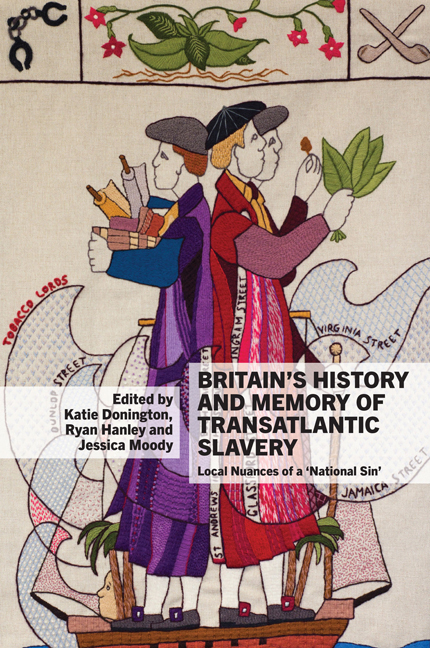Book contents
- Frontmatter
- Contents
- List of Illustrations
- Acknowledgements
- Contributors
- Introduction
- I Little Britain's History of Slavery
- 1 From Guinea to Guernsey and Cornwall to the Caribbean: Recovering the History of Slavery in the Western English Channel
- 2 ‘There to sing the song of Moses’: John Jea's Methodism and Working-Class Attitudes to Slavery in Liverpool and Portsmouth, 1801–1817
- 3 Portrait of a Slave-Trading Family: The Staniforths of Liverpool
- 4 Forgotten Women: Anna Eliza Elletson and Absentee Slave Ownership
- 5 East Meets West: Exploring the Connections between Britain, the Caribbean and the East India Company, c. 1757–1857
- II Little Britain's Memory of Slavery
- Afterword
- Selected Bibliography
- Index
- Plate section
3 - Portrait of a Slave-Trading Family: The Staniforths of Liverpool
from I - Little Britain's History of Slavery
- Frontmatter
- Contents
- List of Illustrations
- Acknowledgements
- Contributors
- Introduction
- I Little Britain's History of Slavery
- 1 From Guinea to Guernsey and Cornwall to the Caribbean: Recovering the History of Slavery in the Western English Channel
- 2 ‘There to sing the song of Moses’: John Jea's Methodism and Working-Class Attitudes to Slavery in Liverpool and Portsmouth, 1801–1817
- 3 Portrait of a Slave-Trading Family: The Staniforths of Liverpool
- 4 Forgotten Women: Anna Eliza Elletson and Absentee Slave Ownership
- 5 East Meets West: Exploring the Connections between Britain, the Caribbean and the East India Company, c. 1757–1857
- II Little Britain's Memory of Slavery
- Afterword
- Selected Bibliography
- Index
- Plate section
Summary
Introduction
In 1769 Joseph Wright of Derby painted an unusual portrait of Thomas Staniforth, a Liverpool merchant with interests in rope-making, Greenland whaling and the African slave trade (see Image 3.1). The face has livid hues of yellows, reds and pinks, an artistic experiment that Wright rarely repeated. Apart from this astonishing portrait, Staniforth disappeared from the mainstream historical record along with many of his mercantile contemporaries from eighteenth-century Liverpool. Even when the portrait was displayed at the Tate Gallery after its purchase in 1965 there was only an oblique reference to Staniforth's mercantile concerns, exemplifying the somewhat myopic public attitude to the slave trade which remained widespread until the bicentenary of its abolition in 2007. By May 2007 there had been a significant shift, the display caption on the Tate's website noting:
Although the slave trade is now considered despicable, there is nothing in Staniforth's portrait to suggest the source of his wealth. Can we detect a hint of cruelty in his cool gaze? […] Wright's portrait seems simply to represent a businessman keen to project the sense of hard-nosed realism that was necessary to succeed in this highly risky trade.
These speculative observations underline the fact that remarkably little is known about the mentality of these key agents in the transfer of thousands of Africans into slavery in the second half of the eighteenth century. Although Liverpool dominated the slave trade in this period, the attitudes of the core of major investors are difficult to discern, despite the fact that slavery became an increasingly contested issue from the 1780s. David Pope has analysed 1,724 investors in Liverpool slaving vessels in the period 1750–1807 and identified approximately 247 individuals who were involved in 20 or more voyages. Pope's meticulous scholarship has also revealed some of the biographical details of his core group of leading slave traders, including their parentage, the value of their personal estates on death and property ownership indicated by the Lists of Lancashire Freeholders of 1794–1795 and the Land Tax Assessments of 1798. Yet, despite this wealth of data, frustratingly little is revealed about the mindset of the Liverpool slave trader, especially major investors such as Thomas Staniforth, who was among the group of the 70 largest traders with 50 or more voyages.
- Type
- Chapter
- Information
- Britain's History and Memory of Transatlantic SlaveryLocal Nuances of a 'National Sin', pp. 60 - 82Publisher: Liverpool University PressPrint publication year: 2016



